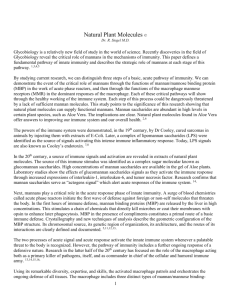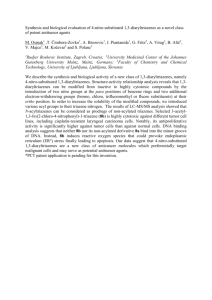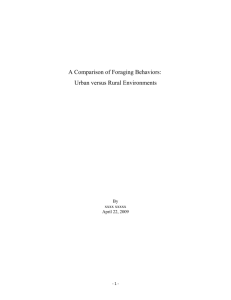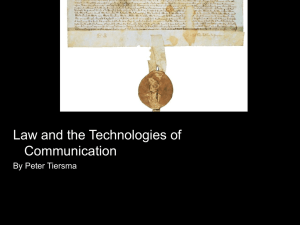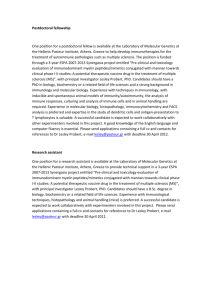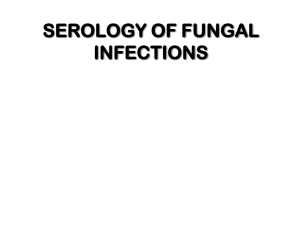The biological activities of mannans and related
advertisement
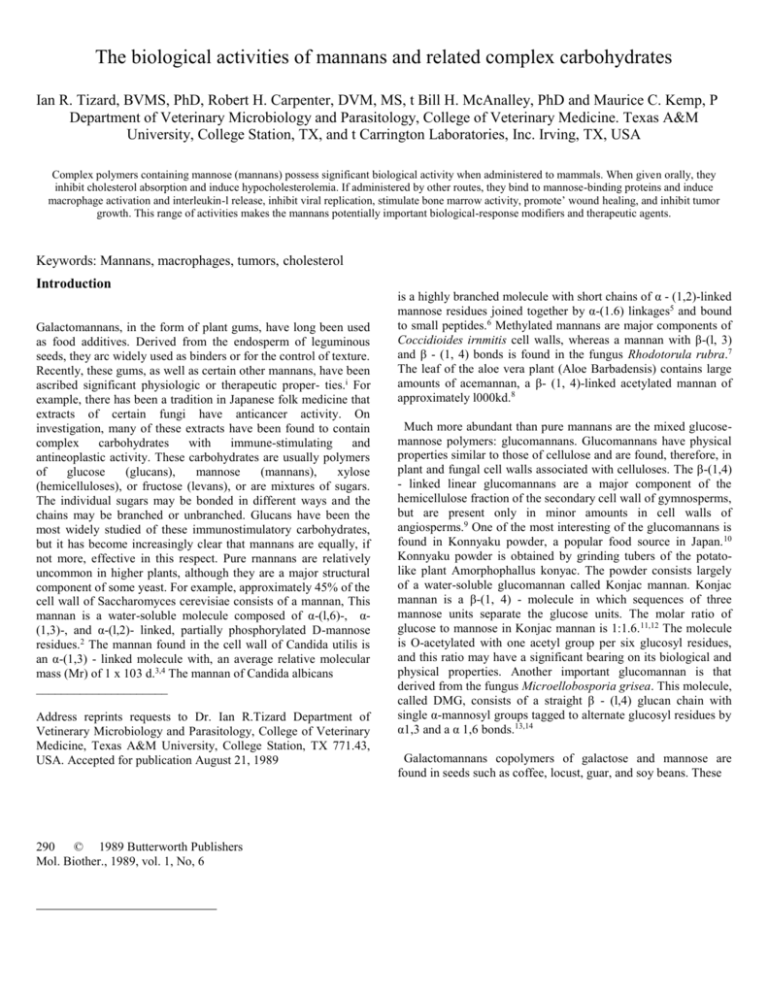
The biological activities of mannans and related complex carbohydrates Ian R. Tizard, BVMS, PhD, Robert H. Carpenter, DVM, MS, t Bill H. McAnalley, PhD and Maurice C. Kemp, P Department of Veterinary Microbiology and Parasitology, College of Veterinary Medicine. Texas A&M University, College Station, TX, and t Carrington Laboratories, Inc. Irving, TX, USA Complex polymers containing mannose (mannans) possess significant biological activity when administered to mammals. When given orally, they inhibit cholesterol absorption and induce hypocholesterolemia. If administered by other routes, they bind to mannose-binding proteins and induce macrophage activation and interleukin-l release, inhibit viral replication, stimulate bone marrow activity, promote’ wound healing, and inhibit tumor growth. This range of activities makes the mannans potentially important biological-response modifiers and therapeutic agents. Keywords: Mannans, macrophages, tumors, cholesterol Introduction Galactomannans, in the form of plant gums, have long been used as food additives. Derived from the endosperm of leguminous seeds, they arc widely used as binders or for the control of texture. Recently, these gums, as well as certain other mannans, have been ascribed significant physiologic or therapeutic proper- ties.i For example, there has been a tradition in Japanese folk medicine that extracts of certain fungi have anticancer activity. On investigation, many of these extracts have been found to contain complex carbohydrates with immune-stimulating and antineoplastic activity. These carbohydrates are usually polymers of glucose (glucans), mannose (mannans), xylose (hemicelluloses), or fructose (levans), or are mixtures of sugars. The individual sugars may be bonded in different ways and the chains may be branched or unbranched. Glucans have been the most widely studied of these immunostimulatory carbohydrates, but it has become increasingly clear that mannans are equally, if not more, effective in this respect. Pure rnannans are relatively uncommon in higher plants, although they are a major structural component of some yeast. For example, approximately 45% of the cell wall of Saccharomyces cerevisiae consists of a mannan, This mannan is a water-soluble molecule composed of α-(l,6)-, α(1,3)-, and α-(l,2)- linked, partially phosphorylated D-mannose residues.2 The mannan found in the cell wall of Candida utilis is an α-(1,3) - linked molecule with, an average relative molecular mass (Mr) of 1 x 103 d.3,4 The mannan of Candida albicans _____________________ Address reprints requests to Dr. Ian R.Tizard Department of Vetinerary Microbiology and Parasitology, College of Veterinary Medicine, Texas A&M University, College Station, TX 771.43, USA. Accepted for publication August 21, 1989 290 © 1989 Butterworth Publishers Mol. Biother., 1989, vol. 1, No, 6 is a highly branched molecule with short chains of α - (1,2)-linked mannose residues joined together by α-(1.6) linkages5 and bound to small peptides.6 Methylated mannans are major components of Coccidioides irnmitis cell walls, whereas a mannan with β-(l, 3) and β - (1, 4) bonds is found in the fungus Rhodotorula rubra.7 The leaf of the aloe vera plant (Aloe Barbadensis) contains large amounts of acemannan, a β- (1, 4)-linked acetylated mannan of approximately l000kd.8 Much more abundant than pure mannans are the mixed glucosemannose polymers: glucomannans. Glucomannans have physical properties similar to those of cellulose and are found, therefore, in plant and fungal cell walls associated with celluloses. The β-(1,4) - linked linear glucomannans are a major component of the hemicellulose fraction of the secondary cell wall of gymnosperms, but are present only in minor amounts in cell walls of angiosperms.9 One of the most interesting of the glucomannans is found in Konnyaku powder, a popular food source in Japan. 10 Konnyaku powder is obtained by grinding tubers of the potatolike plant Amorphophallus konyac. The powder consists largely of a water-soluble glucomannan called Konjac mannan. Konjac mannan is a β-(1, 4) - molecule in which sequences of three mannose units separate the glucose units. The molar ratio of glucose to mannose in Konjac mannan is 1:1.6.11,12 The molecule is O-acetylated with one acetyl group per six glucosyl residues, and this ratio may have a significant bearing on its biological and physical properties. Another important glucomannan is that derived from the fungus Microellobosporia grisea. This molecule, called DMG, consists of a straight β - (l,4) glucan chain with single α-mannosyl groups tagged to alternate glucosyl residues by α1,3 and a α 1,6 bonds.13,14 Galactomannans copolymers of galactose and mannose are found in seeds such as coffee, locust, guar, and soy beans. These seed galactomannans arc usually based on a β-(l, 4) mannan backbone solubilized with short ἀ-(l, 6) - linked galactose side chains. Seed galactomannans may be used as gums, such as guar gum (mannose to galactose ratio, 2: 1) or locust gum (mannose to galactose ratio, 3 to 6: 1), and are incorporated in many foods as texture modifiers and as binders. Mannans (including the galactomannans and glucomannans) are relatively resistant to attack by mannosidases but can be degraded by exomannanases and endomannanases.15-20 Betamannanases have been isolated from wood-rotting bacteria, from human gastrointestinal bacteria, from rumen streptococci, from some seeds, and from arthropod digestive juice.20 Effects of Mannans on Intestinal Function Konjac mannan, like other mannans, forms a viscous gel when mixed with water. This gel causes a number of interesting effects when incorporated in the diet. These include reductions in appetite, glucose absorption, and cholesterol absorption. Thus, treatment of overweight hypertensive patients with oral Konjac mannan, with or without reduced calorie intake, decreases body weight.21 Total plasma cholesterol and triglycerides were lowered in patients treated with this substance, and it was speculated that the weight loss was probably due to satiation as a result of filling of the intestine with mannan gel. When ingested, Konjac mannan gel significantly slows glucose absorption from the intestine.10 For this reason, Konjac mannan has been used to treat “dumping syndrome,” a result of postprandial hypoglycemia that occurs in patients who have had surgical gastrectomy. Because food passes through their stomach at an accelerated rate, these patients have unusually rapid glucose absorption. Consequently, they initially develop hyperglycemia to which they respond with hyperinsulinemia; this in turn rapidly causes severe hypoglycemia. Addition of only 2.6 to 5.2 g of Konjac mannan to a carbohydrate-rich meal slowed the postprandial increase in plasma glucose. When added to the diet of patients with previous gastric surgery, Konjac mannan decreased the postprandial in crease in plasma insulin, preventing the development of hypoglycemia.10,22 Konjac mannan also impairs absorption of an intraduoderial sucrose load or of glucose from an isolated jejunal segment, and it has been suggested that the gel fibers prevent diffusion of sucrose and glucose from the gel mass.23 Plasma cholesterol concentrations animals are markedly influenced by carbohydrates in the diet. Both galactomannans and glucomannans induce a significant hypocholesterolemic response when present at low concentrations (0.5% to 3%) in cholesterolsupplemented diets in rats.23 Guar gum (galactomannan) at levels of 5% to l0% of diet reduced cholesterolemia in chickens fed a basal casein-sucrose diet containing 1% cholesterol.24 In rats, a level of 291 © 1989 Butterworth Publishers Mol. Biother., 1989, vol. 1, No, 6 5% to 19% guar gum was required in the diet to significantly lower serum and liver cholesterol.24 Konjac mannan can also induce hypocholesterolemia.25 The active principle appears to be the mannan itself, since its hydrolysis by cellulase destroyed the hypocholesterolemic activity.26 The activity of the mannan is roughly proportional to the molecular weight of its constituent glucomannans and to its viscosity.10 In adult rats, transport of 14 C -labeled cholesterol into the plasma and liver was significantly reduced by Konjac mannan.27 Konjac mannan probably decreases intestinal absorption of bile salts by interfering with their active transport mechanism.28 In studies using everted ileal sacs, bile acid transport was decreased as much as 50% by the presence of 0.25% Konjac mannan in the mucosal medium. The mannan did not influence the transport of cholic acid, nor did it bind to cholic acid or taurocholate. It did, however, reduce their active transport to 30% to 50% of control values. The minimum effective concentration of Konjac mannan was l0-6 M. Cholesterol uptake from a micellar solution infused into the proximal jejunum in rats was significantly retarded by adding as little as 0.1% Konjac mannan to the micellar solution. The hypocholesterolemic effect of Konjac mannan, therefore, appears to be due to inhibition of cholesterol absorption in the jejunum and of bile salt absorption in the ileum. The effect is reversible when the mannan is removed. Effects of Mannans on the Immune System The most marked biological activities of mannans in mammals are activation of macrophages and stimulation of T cells. As a result, they are potent immunostimulants with significant activity against infectious diseases and tumors. It is predicted that this is where their major influence on human health will lie. Mannose/mannan receptors and binding proteins Macrophages possess protein receptors specific for d- mannose. These receptors are found not only on the surface of the cells but also intracellularly.29 The function of these receptors is to promote pinocytosis and ingestion of mannose-terminated glycoproteins.30 It is probably for this reason that mannosylated liposomes are superior to nonmannosylated liposomes in their immunoadjuvant properties.31 In addition, certain bacteria interact, via mannoseterminating ligands on their surface, with mannose receptors on phagocytes and stimulate a process called lectinophagocytosis. 32 Free mannans can therefore inhibit binding and phagocytosis of yeast particles (zymozan) by mouse peritoneal macrophages, although there are variations in the ability of’ mannans from different sources to do this.33 It is suggested that this is a competitive effect in which free mannan blocks mannose receptors. The most effective inhibitor of yeast phagocytosis is a mannan from a mutant of S cerevisiae. Cell wall mannans with β- (1, 6) linkages and yeast extracellular mannans are much less effective in blocking phagocytosis.34 Once the mannose receptormannan complex is internalized, the ligands are degraded and the receptor recycles back to the cell surface.35 Mannose-binding proteins are also found on hepatocytes and in the spleen, lung, and lymph nodes, and appear to be similar to those on macrophages. 36 A mannose-b protein of 500 kd is found in rabbit serum, whereas the human serum mannose-binding protein is 600 kd.36 It is believed that the function of these proteins is to bind microbial mannans, promoting phagocytosis. Mannose-modified proteins are rapidly ingested by macrophages, while the specific delivery of muramyl dipeptide chemically coupled to mannose-bovine serum albumin (BSA) significantly activates macrophages. 37 Lymphocytes may also possess a mannose or mannan receptor because the phosphomannan-ester core structure from Hansenula holstii blocks the binding of lymphocytes to both rat and mouse peripheral lymph node high endothelial venules.38 Macrophage activation Saccharomyces mannan (150 mg/kg/d) enhances car bon clearance in normal male ddl mice, presumably acting as a reticuloendothelial system stimulant.39 This same mannan also increases the number of anti body-forming cells in the spleen.40 In vitro studies with mouse peritoneal cells (a mixture of macrophages and lymphocytes) indicate that some mannans and mannan-protein complexes can stimulate interferon release both in vivo and in vitro.41 The mannans stimulated interferon release in a manner similar to endo-toxins, but in contrast to endotoxins, caused minimal toxicity.42,43 The mannan from C albicans is active in this way, but the mannan from S cerevisiae is inactive and inconsistent or poor results have been obtained in other laboratories.44 These differences may be due to slight structural or size differences in the polymers.45 The latter is more likely since low (Mr) mannans tend to be most active (5.5 to 20 kd) in the interferon-inducing assay, and mannan from Saccharomyces organisms tends to be larger than mannan from Candida organisms. A galactomannan of 20 kd from Lipomyces starkeyi had weak interferon-inducing properties. In contrast, C albicans mannan induced the appearance of interferon activity 2 to 24 hours after intravenous administration.42 DMG, a degraded mannoglucan from Microellobosporia grisea culture fluid, can stimulate cytotoxic activities of macrophages, natural killer cells, and killer T cells, and it enhances the activities of interleukin-l and colony-stimulating factors. It has more potent antitumor activity than lentinan (a glucan from Lentinus edodes).13,46-7 DMG stimulates macrophages to pro duce increased amounts of interleukin-l; In addition, DMG enhances antibody production against sheep erythrocytes, natural killer activity of the respiratory burst and selectively inhibited extracellular accumulation of myeloperoxidase after a phagocytic stimulus. It has been suggested that the mannan can bind to the neutrophil 292 © 1989 Butterworth Publishers Mol. Biother., 1989, vol. 1, No, 6 spleen and peritoneal cells, and cytostatic activity of penitoneal macrophages.46 Monocytes exposed to acemannan and then cultured with T lymphocytes permitted the T cells to respond in an enhanced fashion to Phytohemagglutinin this result suggests that the mannan Stimulated release of helper factors from monocytes. Acemannan alone is not directly mitogenic for T cells. 8 Antiviral effects Mannose-binding proteins have been identified ii the serum of rabbits and in the liver and serum of humans and laboratory rodents. These proteins can bind glucomannans, such as those found in cell walls of bacteria, yeasts, and fungi and in envelope glycoproteins of certain viruses, such as the human immunodeficiency virus (HIV). In humans, the major mannosebinding protein is an acute-phase protein; its levels increase in stressed individuals.48 The envelope glycoproteins of HIV (gp 120 and gp 41) contain mannose-rich oligosaccharides that appear to be potential ligands for the mannose-binding protein. As a result, the mannose binding protein can inhibit HIV infections of lymphoblasts and bind selectively to H1V-infected cells. Free yeast mannan can competitively interfere with binding of this protein to infected cells. Thus, factors that induce an increase in the level of the mannose-binding protein may confer protection against HIV. Immunosuppression Both cell- and neutrophil-mediated fungicidal activities may be depressed in patients with candidiasis.49 Binding of myeloperoxidase to target yeasts is required for the killing of C albicans.50 The addition of soluble mannan significantly reduced myclopcroxidase-mediated killing in a dose-dependent manner by antagonizing binding of myeloperoxidase to the yeasts. Soluble mannan was demonstrated to have a similar dose-dependent inhibitory effect on neutrophil-mediated candidacidal activity without influencing phagocytosis of the organism. A factor derived from the serum of patients with chronic mucocutaneous candidiasis inhibits cell-mediated immune function (lymphocyte proliferation) and has been characterized as a soluble mannan from the yeast cell walls.51 Saccharomyces mannan has been tested for its effect on human neutrophil functions.52 The mannan reduced myeloperoxidase because they cosediment on centrifugation.49 The mannan facilitates the attachment of the enzyme to the surface of target yeasts to increase fungicidal activity of the enzyme.53 The soluble mannan is inhibitory for both extracellular and intracellular killing of Candida yeasts.50 Mannan concentrations of over 100 ụg /ml have been measured in the serum of patients with systemic candidiasis. Detection of this can be used for diagnostic purposes.54 Inhibition of neutrophil binding to C albicans was specifically blocked by purified mannans from Candida organisms; this suggests that neutrophils bind to these fungi by means of a mannan receptor on their surface.55 Blockage, however, was only effective at high mannan concentrations. It is more likely that the natural blockers of neutrophil adhesion in Candida supernatants are mannoproteins.56 S cerevisiae mannan slightly inhibited peritoneal macrophage phagocytosis of C albicans yeast cells, either unopsonized or opsonized by C3. It had no effect when these same yeasts were opsonized with normal human serum or immunoglobulins. The mannan had no effect on phagolysosome fusion.57 Mannan isolated from S cerevisiae can inhibit responses of lymphocytes in vitro to Phytohemagglutinin and pokeweed mitogen, as well as to Candida organisms, streptococcus, mumps, and cytomegalo- and herpes simplex virus.58 This is largely due to the presence of copper in the mannan and possibly due to the superoxide dismutase activity of the copper-mannan complex. The mannan increased hydrogen peroxide production and decreased superoxide production in dose-dependent manner. It did the same for neutrophils and macrophages. Thus, H2O2 accumulated in the lymphocyte cultures. Chelating the copper removed most of the inhibiting activity. The accumulated H 2O2 may have been mildly toxic for the lymphocytes.58 Bone marrow stimulation Mannan-A is a bone marrow stimulant and can protect mice against cobalt-60 radiation when given before radiation. If given after irradiation, mannan-A enhances endogenous colony formation.59 DMG also increases the level of granulocyte / macrophage colony-stimulating activity in serum. Mannan-R is ineffective in this regard.59 Wound Healing Healing of burns was enhanced in guinea pigs treated with aloe vera extract.60 It is believed that the active fraction of this extract is acemannan. Guinea pigs received full-thickness burns covering 3% of their body surface. The dressings on these burns were changed daily and the wounds were examined. The average time to complete healing in the control group was 50 days. The only significant difference was found in the aloe vera treated animals, which healed in an average of 30 days. Wound bacterial counts were also significantly depressed by the aloe vera extract. 60 In contrast to these results, Kaufman et al.61 found that an aloe vera extract hindered healing of experimental second-degree burns in guinea pigs. However, a review of the techniques used to produce the aloe vera extract for Kaufman et al. ‘s experiments suggests 293 © 1989 Butterworth Publishers Mol. Biother., 1989, vol. 1, No, 6 that ace-mannan was removed or destroyed since no attempt was made to stabilize the product by destroying mannanases. The extract was also treated with activated charcoal, a process that removes acemannan. Effects of Mannans on Tumors Although common polysaccharides such as starch (an ἀ- (1,4) glucan), dextran (an ἀ-(l,6) glucan), and insulin (a fructan), do not have antitumor activity,62 there is abundant evidence that mannans and selected glucans are potent anti-cancer agents.63 The factors that determine whether a polysaccharide will have antitumor activity are unclear. However, there appears to be a direct relationship between the antitumor activity of polysaccharides and their ability to interact with serum albumin.64 This may simply reflect the ability of these molecules to bind to proteins. The soluble D- glucans have antitumor activity if they are mainly linear, without excessively long branches, and are relatively resistant to degradation by glucanases.64 Thus, glycogen, starch, and dextrans are inactive. Compounds with long stretches of β-(l, 3) linkages are effective.64 Loss of tertiary structure by denaturation also causes loss of activity. Dextrans may be activated if attached to diethylaminoethyl groups. Studies on synthetic β-(l , 6)- linked celluloses suggest that antitumor activity against sarcoma- l80 is greatest in molecules with a high degree of polymerization and a homogeneous distribution of side chains. 65 One of the earliest records of polysaccharide anti-tumor activity was recorded in 1947 by Diller,66 who showed that Serratia marcescens polysaccharide induced destructive changes in transplantable mouse sarcoma-37. Other early studies67 indicated that when injected intraperitoneally, a polysaccharide from Candida guillermondi resulted in regression of sarcoma-37 in 67% of treated animals versus 6% of controls. Histological examination revealed severe necrosis of the tumor. It has been suggested that the effect of these bacterial polysaccharides is due to a reduction in tumor blood flow as a result of hypotension. 68 Mannans with significant antitumor activity have been isolated from several species of yeast and have been tested for activity against sarcoma-180.69 (Sarcoma- 180 is an experimental mouse tumor that is remarkably susceptible to immunological attack. As a result, it is used as a screening system for immunologically mediated antitumor activity.70 It is also of interest that immunity to sarcoma-180 can be transferred by peritoneal exudate cells but not by spleen cells, lymph node cells, or serum, 71suggesting that the immunity is due to enhanced macrophage activity). Effects Mannan fractions from five species of yeast, C albicans B-792, C albicans A-207, C stellatoidea, C utilis, and S cerevisiae, were tested for activity against sarcoma-180 in Swiss albino mice.69 The inhibiting activity at the end of 5 weeks was 99%, 65%, 82%, 10% mannan. The peak blood level was reached 3 hours after intraperitoneal inoculation. mannan accumulated in the sarcoma as well as in the liver and spleen of injected mice.74 The tumor took up about 10% of the and 91%, respectively. There appeared to be no relationship between the amount of glucose in these mannans and their activity, although this is disputed: However, the mannan from C utilis, which contained an ἀ-linked glucose, was poorly inhibitory, whereas the fraction from C albicans B-792, which has a β-g1ucan component, was highly active. It was suggested that the antitumor activity depends on the presence of the β-linkages. Mannans from S cerevisiae” and C utilis inhibit the growth not only of sarcoma-18073,74 but also of 3-methylcholanthrene-induced tumors,75,76 Ehrlich carcinoma, and NF sarcoma. None of these mannans are active against the ascites form of sarcoma180.72 The mannoglucan from M grisea has antitumor activity against the MH 134 hepatoma in C3H/He mice.77 Inhibition of the development of 3-methylcholanthrene - induced tumors occurred in mice pretreated daily with S cerevisiae mannan,76 3-Methyicholcholanthrene in benzene was applied to the skin of 4-week-old ddl strain mice. Before application of 3methylcholanthrene, the mice received ten daily injections of S cerevisiae mannan (100 mg/kg/d intraperitoneally). After exposure, they received the same do three times a week. Ten malignant tumors developed in the 20 control mice, whereas only two tumors de- veloped in the mannan-treated animals. The average diameter of the tumors in the control animals was 8.6 mm; in the treated animals, it was 2.0 mm. A hot-water extract of C utilis composed mainly of mannan had a significant inhibitory effect on subcutaneously transplanted sarcoma-180 in mice when it was given as ten daily intraperitoneal injections (100 mg/kg/d) started 24 hours after tumor inoculation.3 This same extract also slightly inhibited Ehrlich carcinoma and NF sarcoma. It had no effect on growth of the ascites form of the tumor or of Yoshida sarcoma. In spite of minor structural differences between the mannans of C utilis and S cerevisiae, they show similar spectra of antitumor activity. Polymerization appears to be essential for the antitumor activity of these mannans because hydrolysis to small polymers (one sixth of the original size) results in loss of activity. 76 In addition, it has been suggested that these antitumor mannoglucans share a unique tetrasaccharide repeating-unit structure and (Mr) of approximately 3 to 10 x 102 kd.46 The carboxymethyl derivative of this Candida organism mannan was also tested in the sarcoma-180 system. The derivative was administered by several different routes, the most effective of which were intraperitoneal and intravenous. Much less effective was subcutaneous and oral administration. Antitumor efficacy was similar to the unmodified mannan, and the most effective size was 20 to 30 kd78.Tritium-labeled carboxymethyl Candida sp. 294 © 1989 Butterworth Publishers Mol. Biother., 1989, vol. 1, no.6 MG, the mannoglucan from M grisea, lentinan (a branched glucan from Lentinus edodes), bacterial lipopolysaccharide, and TAK (a linear glucan from Alcaligenes faecalis) were tested for antitumor activity by inoculation directly into the MH 134 hepatoma in C3H/He mice. 77All but TAK had similar antitumor activity when administered intraperitoneally but different activities when administered directly into the tumor. MG and lentinan had the most potent activity intratumorally. These compounds caused almost complete regression of the tumor, whereas TAK had no detectable antitumor activity. MG has potent antitumor activity against the Ehrlich carcinoma and against MM46 syngeneic adenocarcinoma, with high rates of complete regression. 47 Mode of action When mannoglucan prepared from M grisea was administered intravenously to C3H mice bearing the solid MH 134 hepatoma, the blood circulation in the tumor was inhibited within 6 hours and tumor growth was retarded within 3 days. The tumor mass was excised and extracted at various intervals after administration of mannan. A cytotoxic factor was produced that was detectable in the tumor homogenate by an 8-hour cytolysis assay against L929 fibroblasts. With out mannoglucan treatment, the cytotoxic activity was absent. The molecular size of the factor was 70 to 80 kd, and it is probably a type of tumor necrosis factor since the cytotoxic factor was inhibited by anti- tumor necrosis factor (TNF) serum. The dose dependencies of the cytotoxin and TNF were similar.77 Yeast mannan can induce a stronger antitumor response in the sarcoma- 180 system of mice than the glucan from the same source.3 Lymphocytes isolated from the regional lymph nodes of mice that were previously injected with glucan or mannan can inhibit growth of sarcoma-l80 cells in vivo.40 The antitumor activity of mannans is probably a direct result of their macrophage -stimulating activity. Thus, ingestion of large mannan molecules causes secretion of interleukin-l, interferon, and TNF. Their lack of significant toxicity, in combination with this stimulating activity, makes mannans prime candidates for further investigation as antitumor agents. References I. Davis SE. Lewis BA, Physiological effects of mannans galactomannans and glucomannans. In: Jeanes A, Hodge J, eds. American Chemical Society Symposium Series 15, Washington, DC American Chemical Society. 1975. 2. McMurrough I, Rose AH, Effect of growth rate and substrate limitation on the composition and structure of the cell will of Saccharomyces cerevisiae. Biochem / 1967; 105:189-203 3. Oka S., Kumano N., Sato K. et al. Antitumor activity of some plant polysaccharides II. Chemical constituents and antitumor activity of yeast polysaccharide, Gann 1969; 60:287-93. 4. Oka S., Okamura N, Kits S. et al., Antitumor activity of some plant polysaccharides. I. Fractionation and antitumor activity of basasse polysaccharide. Gann, 1968; 58:35-42 21. Reffo CC, Ghirardi FE, Forattini C. Glucomannan in hypertensive patients: Pilot clinical trial. Curr Therapeutic Res 1988; 44:22-7. 5. Bishop CT, Blank F, Gardner PE. The cell wall polysaccharides of Candida albicans: Glucan, mannan, and chitin. Can J Chem 1960; JL8 295 © 6. Saxena A., Hammer CF., Cihlar RL. Analysis of mannans of two relatively avirulent mutant strains of Candida albicans. Infect Immun 1989; 57:413-9. 7. Wheat RW, Woodruff WW. , Haltiwanger RS. Occurrence of antigenic (species-specific?) partially 3-O-mcthylatcd heteromannans in cell wall and soluble cellular (non-wall) components of Coccidioides immitis mycelia. Infect Immun 1983; 41:728-34. 8. Womble D., Helderman JH., Enhancement of alloresponsiveness of human lymphocytes by acemannan (Carrisyn®). Int. J Immunopharmacol.1988; 10:967-74. 9. Ramsdcn L., Northcote DH. Glucomannan synthesize from suspension cultures, of Pinus sylvestris. Phytochemistry 1987; 26:2679-83. 10. Ebihara K, Masuhara R, Kiriyama S. Effect of konjac mannan, a water soluble dietary fiber on plasma glucose and insulin responses of young men undergone glucose tolerance test. Nutr Rep Int. 1981, 23:577-83. 11. Kato K, Matsuda K. Studies on the chemical structure of konjac mannan. Part I. Isolation and characterization of oligosaccharides from the partial acid hydrolyzate of the mannan. Agr Biol Chem 1969; 33:1446-53. 12. Kato K, Watanabe T, Matsuda K. Studies, on the chemical structure of konjac mannan, Part II. Isolation and characterization of oligosaccharides from enzymatic of the mannans. Agr Biol Chem 1970: 34; 532-9. 13. Inoue K. Kawamoto KK, Kadoya S. Structural studies on an antitumor polysaccharide from Microellosporia grisea. Carbohydrate Res 1983: 114:245-56. 14. Nakajima H. Kita Y. Takashi T et al. Immunopotentiation by a new antitumor polysaccharide. DMG, a degraded D-manno-D glucan from Microellobosporia grisea culture fluid. Gann 1984; 75: 260-8. 15. Emi S. Fukomoto J. Yamamoto T. Crystallization and some properties of mannanase. Agr Biol Chem 1972: 36:991-1001. 16. Snaith SM. Levvy GA. α-D-Mannosidase. Adv Carbohydrate Chem Biochem 1973; 28:401-45. 17. Herman RH. Mannose metabolism 1. Am J Clin Nutr 1971; 24: 488-98. 18. McMaster W, Desbaillets L, Menguy R. Glycosidases in canine pancreatic secretion. Proc Soc Exp Biol Med 1970: 135:87-90. 19. Jones GH, Ballou CE. Isolation of a α- mannosidases which by hydrolyses yeast mannan. J Biol Chem 1968; 243:2442-46. 20. Eriksson K-E Winell M. Purification a characterization of a fungal β-mannase. Acta Chem Scand 1968: 22:1924-34. 1989 Butterworth Publishers Mol. Biother., 1989, vol. 1, no.6 22. Ebihara K. Masuhara R, Kiriyama S. Major determinants of plasma glucose-flattering activity of a water-soluble dietary fiber: Effects of konjac mannan on gastric emptying and intraluminal glucose diffusion. Nutr Rep Int 1981; 23:1145-56. 23. Hopman WPM. Houben PGMP. Speth PAJ, Lamers CBHW, Glucomannan prevents postprandial hypoglycemia in patients with gastric surgery. Gut 1988; 29:930-4. 24. Riccardi BA. Fahrenbach MJ. Effect of guar gum and pectin N.F. on serum and liver lipids of cholesterol fed rats. Proc Soc Esp. Biol Med 1967: 124:749—52. 25. Kiriyama S, Morisaki H, Yoshida A. Changes in hypocholesterolemic activity in rats by various Konnyaku powder treatments. Agr Biol Chem; 1970; 34:641-3. 26. Kiriyama S. Ichihara Y. Enishi A. Yoshida A. Effect of purification and cellulase treatment on the hypocholesterolemic activity of crude konjac mannan. J Nutr 1972; 102:1689-98. 27. Kodama. T. Nakai H, Kiriyama S. Yoshidi A. Hypocholesterolemic mechanisms of non-nutritive polysaccharides (konjac mannan, pectin, and carboxymethyl) in foods. J Jpn. Soc Food Nutr 1972; 25:603-8. 28. Kiriyama S. Enishi A. Yura K. Inhibitory effects of konjac mannan on bile acid transport in the everted sacs of rat ileum. J Nutr 1974; 104:69-78. 29. Lee YC. Mannose binding proteins of animal origin. Adv Esp. Med Biol 228:103-21. 30. Stahl P. Gordon S. Expression of a mannosyl-fucosyl receptor for endocytosis on cultured primary macrophages and their hybrids. J Cell Biol 1982; 93:49-56. 31. Garcon N. Gregoriadis G. Taylor M. Summerfield J. Mannose mediated targeted immunoadjuvant action of liposomes. Immunology 1988; 64:743-5. 32. Ofek I. Sharon N. Lectinophagocytosis: A molecular mechanism of recognition between cell surface sugars and lectins in the phagocytosis of bacteria. Infect Immunol 1988; 56:539-47. 33. Sung SJ, Nelson RS, Silverstein SC. Yeast mannan inhibit binding and phagocytosis of zymosan by mouse peritoneal macrophages. J Cell Biol 1983; 96:160-6. 34. Sung S-SJ. Nelson RS, Silverstein SC. Mice peritoneal macrophages plated on mannan - and horseradish pcroxidase coated substrates lose the ability to phagocytosis by their Fc receptors. J Immuno 1983: 134; 3712-17. 35. Tietze C, Schlesinger PH, Stahl P. Mannose-specific endocytosis receptor of alveolar macrophages: Demonstration of two functionally di intracellular pools of receptor and their roles in receptor cycling. J Cell Biol 1982: 92:417-24. 36, Kawasaki N. Kawasaki T. Yamashina, I. Isolation and characterization of mannans-Binding protein from human serum. J Biochem (Tokyo) 1983; 94:937-47. 49. Wright CD. Bowie JU. Gray CR, Nelson RD. Candidacidal activity of myeloperoxidase: Mechanism of inhibitory influence of soluble cell wall mannan. Infect Immun 1983; 42:76-80. 50. Lehrer RI, Kline MJ. Leukocyte myeloperoxidase deficiency and disseminated candidiasis: The role of myeloperoxidase in resistance to Candida infection. J Clin Invest 1969; 48:1478-88. 296 © 1989 Butterworth Publishers Mol. Biother., 1989, vol. 1, No, 6 37. Roche AC. Midoux P, Mayer R, Monsigny M. Activation of murine macrophages and human monocytes by membrane lectinmediated endocytosis of activators, bound to neoglycoproteins. Proceedings of the Eighth International Symposium on Glycoconjugates, Houston, TX. New York. Praeger, 1985, p. 569. 38. Yednock TA, Stoolman LM. Rosen SD. Phosphomannosyl derivatized beads detect a receptor involved in lymphocyte homing. J Cell Biol 1987; 104:713-23. 39. Suzuki M, Chaki F. Suzuki S. Effect of yeast polysaccharides treatments on the carbon-clearance activity of mice implanted with sarcoma-180 solid tumor. Gann 1971; 62:553-6. 40. Suzuki S. Suzuki M, Matsumoto T, Okawa Y. Growth inhibition of sarcoma- 180 solid tumor by the cells of regional lymph node and spleen of mice administered with yeast polysaccharides. Gann 1971; 62:343-52. 41. Lackovic V. Borecky L. Sikl D. Master L. Bauer S. Stimulation of interferon production by mannans. Proc Soc Esp. Biol Med 1970; 134: 874-9. 42. Borecky L. Lackovic V. Blaskovic D. Masler L. Sikl D. An interferon-like substance induced by mannans. Acta Virol 1967; 11:264-6. 43. Hasenclever HF, Mitchell WO. Immunological studies on polysaccharides of yeasts. J Immun 1964; 93:763-71. 44. DeClercq E, Eckstein F. Merigan TC. Structural requirements for synthetic polyanions to act as interferon inducers. Ann NY Acad Sci 1970; 173:444-61. 45. Suzuki S. Sunayama H. Saito T. Studies on the antigenic activity of yeasts. 1. Analysis of the determinant groups of the mannans of Saccharomyces cerevisiae. Jpn J Microbial 1968; 12:19-24. 46. Nakajima H, Hashimoto S. Nagao S. et al. Host-mediated anti tumor effect of DMG, a degraded D-manno-D-glucan from Micraellobasporia grisea culture fluid. Gann 1984; 75:253-9. 47. Inoue K. Nakajima H. Kohno M. et al. An antitumor polysaccharide produced by Microellobosporia grisea: Preparation general characterization, and antitumor activity. Carbohyd. Res 1983; 114:164-8. 48. Ezekowitz RA. Kuhlman M. Groopman JE. Byrn RA. A human serum mannose-binding protein inhibits in vitro infection by the human immunodeficiency virus. J. Exp Med 1989; 169:185-96. 51. Fischer A. Ballet J. Griscoll C. Specific inhibition of in vitro Candida induced lymphocyte proliferation by polysaccharide antigens present in the serum of patients with chronic mucocutaneous candidiasis. J Clin Invest 1978; 62:1005-13. 52. Wright CD. Herron MJ. Gray GR. Holmes B. Nelson RD. Influence of yeast mannan on human neutrophil functions: Inhibition Lion of release of myeloperoxidase related to carbohydrate binding property of enzyme. Infect Immun 1981; 32:731-8. 53. Lehrer RI. Antifungal effects of peroxidase systems. J Bacterial 1969; 99:361-5. 54. Weiner MH, Youni WJ. Mannan antigenemia in the diagnosis of invasive Candida infections. J Clin Invest 1976; 58:1045-53. 55. Diamond RD. Krzesicki R. Mechanisms of attachment of neutrophils to Candida albicans pseudohyphae in the absence of serum and subsequent damage to pseudohyphae by microbicidal processes of neutrophils in vitro. J. Clin Invest 1981; 61:360-9. 56. Diamond RD. Oppenheim F. Nakagawa Y. Krezesicki R. Haudenschild CC. Properties of’ product of Candida albicans hyphae and pseudohyphae that inhibits contact between the fungi and human neutrophils in vitro. J. Immunol 1980; 125:2797-2804. 57. Kolotila MP. Rogers AL. Beneke ES. Smith CW. The effects of soluble Saccharomyces cerevisdiae mannan on the phagocytosis of Candida albicans by mouse peritoneal macrophages in vitro. J. MedVei Myco 1987; 25:85-95. 58. Nelson RD. Herron MJ. McCormack RT. Gehrz RC. Two mechanisms of inhibition of human lymphocyte proliferation by soluble yeast mannans polysaccharide. Infect Immun 1984; 43:1041-6. 59. Paichen ML. DiLuzio NR. Jacques P. MacVittie TJ. Soluble polyglycans enhance recovery from cobalt-60 induced hemopoietic injury. J. Biol Resp. Mod l984; 3:627-33. 60. Rodriguez-Bigas M. Cruz NJ. Suarez A. Comparative evaluation of aloe vera in the management of burn wounds in guinea pigs. Plast Reconstir Surg 1988; 81:386-9. 61. Kaufman T. Kalderon N. Ullmann Y. Berger J. Aloe vera gel hindered wound healing of experimental second-degree burns: A quantitative controlled study. J. Burn Care Rehabil 1988; 9: 1569. 62. Hamuro J. Chihara G. Effect of antitumor polysaccharides on the higher structure of serum protein. Nature 1973: 245:40-1. 63. Kamasuka T. Momoki Y. Sakai S. Antitumor activity of polysaccharide fractions prepared from some strains of Basidiomycetes. Gann 1968; 59:443-5. 64. Whistler RL. Bushway AA. Singh PB. Nakahara W. Tokuzen R. Noncytotoxic, antitumor polysaccharides. Adv. Carbohydr Chem Biochem 1976; 32:235-75. 72. Oka S. Kumano N, Sato K. et al. Antitumor activity of some plant polysaccharide. II. Chemical constituents and antitumor activity of yeast polysaccharide. Gann 1969; 60:287-93. 73. Kumano N. Kurita K. Oka S. Distribution of carboxymethylated yeast mannan in normal and tumor bearing mice. Gann 1972; 63:675-83. 65. Matsuzaki K, Yamamoto I. Sato T. Synthesis of water-soluble branched polysaccharide, and their antitumor activity. 1. Branched polysaccharides from cellulose acetate. Makromol Chem 1985; 186:449-36. 66. Diller IC. Degenerative changes induced in tumors by S. marcescens polysaccharide. Cancer Res. 1947; 7:605-26. 67. Zankowski ZT. Yamashita M. Diller IC. The effect of Candida guillermandi polysaccharide on transplantable mouse sarcoma 37. Proc Soc Esp. Biol Med 1957: 96:79-80. 68. Algire GH. Legallais FY. Anderson BF. Vascular reactions of normal and malignant tissues in vivo. V. The role of hypotension in the action of a bacterial polysaccharide on tumors. JNCI 1952; 12:1279-91. 69. Suzuki S. Hatsukaiwa H. Sunayama H. et al. Antitumor activity of polysaccharides. II. Growth - activity of mannan fractions isolated from several species of yeast against sarcoma 180 solid tumors. Gann 1969; 60:65-9. 70. Bradner WT, Clarke DA. Stimulation of host defense against experimental cancer. II. Temporal and reversal studies of the zymosan effect. Cancer Res 1959; 19:673-8. 74. Abe S. Takasashi K. Tsubouchi J. Aida K. Yamazaki M. Mizuno D. Different local therapeutic effects of various polysaccharides on MHl34 hepatoma in mice and its relation to inflammation induced by the polysaccharides. Gann 1984: 75:459-65. 75. Kumano N. Kurtia K. Oka S. Inhibition of the development of3-methylcholanthrene-induced mouse tumor with the yeast mannan preparation. Gann 1973; 64:529-33. 76. Oka S. Kumano N. Kurita K. Antitumor activity of the yeast mannan preparation in relation to the effect of chemical modification. Gann 1972; 63:365-9. 77. Takahashi K. Watanuki Y. Yamazaki M, Abe S. Local induction of a cytotoxic factor in murine tumour by a systemic administration of an antitumor polysaccharide. Br. J. Cancer 1988; 57:170-3. 78. Suzuki S. Suzuki M. Hatsukaiwa H. et al. Antitumor activity of polysaccharides. III. Growth-inhibitor activity of purified mannan and glucan fractions from baker’s yeast against sarcoma180 solid tumor. Gann 1969; 60:273-7. 71. Macda Y. Chihara G. Periodical consideration on the establishment of antitumor action in host and activation of peritoneal exudate cells by lentinan. Gann 1973; 64.351-7. 296 © 1989 Butterworth Publishers Mol. Biother., 1989, vol. 1, No, 6
